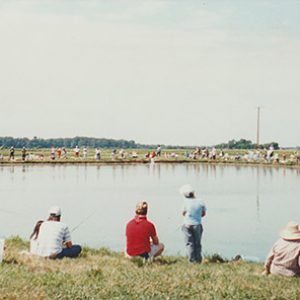calsfoundation@cals.org
Joe Hogan Fish Hatchery
Since 1928, the Joe Hogan State Fish Hatchery near Lonoke (Lonoke County) has produced fish for stocking Arkansas lakes and streams. It is the oldest and largest of the four warm-water hatcheries run by the Arkansas Game and Fish Commission (AGFC) and is the largest and one of the oldest state-owned warm-water pond hatcheries in the United States.
Early in 1928, AGFC chairman Lee Miles instructed AGFC secretary Guy Amsler to look for available land near Lonoke for the construction of a fish hatchery. The site purchased for the hatchery was a half mile south of Lonoke and consisted of two adjacent rice farms totaling 266 acres and located along present-day U.S. Highway 70. The commission earmarked $17,544 for purchasing materials to construct the ponds. Dell Brown, with the U.S. Bureau of Fisheries and supervisor of the Mammoth Springs National Hatchery, was chosen as the hatchery superintendent. Joe Hogan, who was also working for the U.S. Bureau of Fisheries at the time, was hired to assist Brown during the construction. He assumed the position of operating the hatchery after it was completed.
Pond construction for the hatchery took place in the fall of 1928. Due to the lack of mechanized machinery, the early ponds were dug by mules pulling dirt slips and by laborers using shovels to load dirt onto wagons by hand. The soil had enough clay material to make pond levees that could hold water. Another crucial factor was that the water table was about sixty feet, and the alluvial water in the subterranean sand formation provided plenty of water for filling the ponds. During the initial phase of construction, thirty-two ponds covering forty acres were built. They ranged in size from three-fourths of an acre to two and a half acres.
In the spring of 1929, only a few of the ponds were complete to the point that they were usable. Wild stock of largemouth bass and bluegill bream were captured from the White River and stocked in the available ponds. The first crop of fish was produced that same year. The commission continued to build rearing ponds after World War II and into the 1950s, until eventually the hatchery encompassed fifty-six ponds covering 214 acres of water. Because of its location near the town of Lonoke, the hatchery was first known as the Lonoke Fish Hatchery. In 1956, it was renamed the Joe Hogan State Fish Hatchery in honor of the first supervisor of fisheries.
The standard fish currently reared at the hatchery are warm-water species that include largemouth bass, bluegill bream, redear bream, crappie, channel catfish, blue catfish, and white amur. Over the years, the hatchery has experimented with raising species such as smallmouth bass, walleye, saugeye, striped bass, striped bass hybrids, hybrid bream, Israeli carp, buffalo, and paddlefish. The hatchery produces approximately three to four million fish annually for Arkansas’s public lakes and streams. In addition to stocking public waters, the hatchery provides some species of fry and fingerling fish for the other three warm-water state fish hatcheries and for other state conservation agencies. The hatchery also provides over 250,000 eight-inch catfish to the Pot Shoals Net Pens on Bull Shoals Lake and the Jim Collins Net Pens on Lake Ouachita, which are also owned and operated by the AGFC. These facilities grow the catfish to a larger size to stock area lakes.
The hatchery has made great strides in the advancement of fish culture work. In the beginning, the hatchery simply collected adult fish from the wild and placed them in hatchery ponds for spawning. The fish were hauled to lakes and streams in ten-gallon milk cans and in wooden barrels in the back of a Model A truck. In the 1940s, larger tanks made of cypress lumber were built and used to transport fish. The hatchery now uses modern transport trucks with custom-made fish-hauling tanks that are insulated to maintain a constant temperature. Liquid oxygen is used to provide optimum conditions for the fish.
In the early days of the AGFC, the hatchery indiscriminately stocked fish wherever it thought they might be needed, without much scientific research or evaluation of the fish populations of that particular lake or stream. In the 1950s, the commission for the first time hired five fisheries biologists and stationed them in various regions around the state in order to manage the fish populations on the lakes in their respective regions.
Joe Hogan served as the superintendent from 1928 through 1960. In 1961, Lee Brady was appointed foreman of the fish hatchery, serving in that position until 1972. In 1972, Berry Beavers was appointed as hatchery manager.
Wildlife viewing opportunities are excellent at the Joe Hogan State Fish Hatchery. Shorebirds and waterfowl are common during their migration periods. Mammals such as mink and muskrat can be seen, as well as aquatic reptiles and amphibians. The hatchery grounds are open for public viewing from daylight to dark, seven days a week. The Lee Brady Visitor Center has a self-guided tour and is open Monday through Friday from 8:00 a.m. to 4:00 p.m.
For additional information:
Arkansas Game and Fish Commission. http://www.agfc.com (accessed October 4, 2022).
Arkansas Game and Fish Commission. Arkansas Wildlife: A History. Fayetteville: University of Arkansas Press, 1998.
McGraw, Shirley, and Carol Bevis. Lonoke County, Arkansas: A Pictorial History. Virginia Beach, VA: The Donning Company, 1998.
Berry Beavers
Arkansas Game and Fish Commission
 Aquaculture
Aquaculture AGFC Fingerling Stocking
AGFC Fingerling Stocking  AGFC Pond Stocking
AGFC Pond Stocking  Fishing Day
Fishing Day  Fishing Day
Fishing Day  Hatchery Grounds
Hatchery Grounds  Hatchery Workers
Hatchery Workers  Joe Hogan Fish Hatchery
Joe Hogan Fish Hatchery  Joe Hogan Fish Hatchery
Joe Hogan Fish Hatchery  Joe Hogan Fish Hatchery Truck
Joe Hogan Fish Hatchery Truck  Joe Hogan Fish Hatchery
Joe Hogan Fish Hatchery  Joe Hogan Fish Hatchery
Joe Hogan Fish Hatchery  Joe Hogan Fishing Derby
Joe Hogan Fishing Derby 



Comments
No comments on this entry yet.